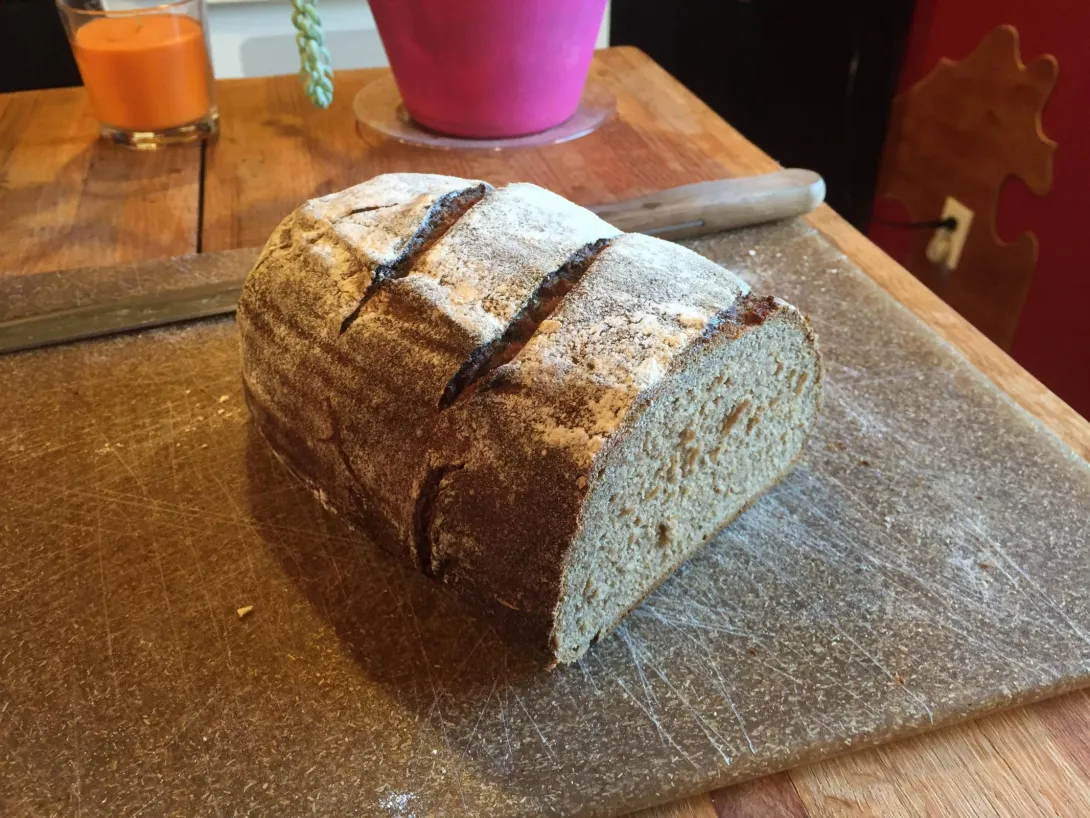
I'm a long time stalker to this site, and I finally made an account to see if I can get some advice about rye breads. A local bakery has an amazing "German Beer Bread" which I have been yearning to duplicate. In Germany, I picked up a book called "Rustikale Brote aus deustchen Landen" by Gerhard Kellner, or better known as Ketex. Below is the recipe, and I explain how I baked it. Ultimately, I have a question about the rather dense crumb. But don't let that discourage you from baking this thing- it is insanely delicious.
In his book, and here on his blog (http://ketex.de/blog/brotrezepte/sauerteig/roggen/schwarzbierroggenbrot/) I found this wonderful recipe.
Sourdough:
230g Roggenmehl 1150 (I used a medium rye flour from a local mill)
230g Water
23g Rye Sourdough Starter
The recipe called for this to be set out for 16-18 hours, but I opted for about 8-10, knowing that I would be retarding the shaped loaf overnight.
For the main dough:
All of the Sourdough
240g Roggenvollkornmehl (I used course ground whole rye)
220g Roggenmehl 1150
12g Salt
ca. 240 Schwarzbier (a German black lager, such as Kröstlizter; I used Uinta Brewery Black Lager)
10g Fresh Yeast (I used 5 grams instant yeast)
After the sourdough sat for 9 or so hours, I threw the dough together without the salt and let it autolyse for 1 hour. Then I mixed in the salt with a little water a la Tartine, and as per the instructions, put it in the stand mixer to knead for 7 minutes. Kneadless to say (ba-dum chik!) the dough hook barely grabbed on to the dough. Is there enough gluten in rye to necessitate kneading when working with 100% rye? Anyway, I tried to follow the recipe.
Thereafter, I bulk fermented for 2 hours, shaped, and placed the dough into a flour oval banneton. I retarded the dough overnight, and when I removed it from the fridge prior to baking, the dough had risen about 1-2".
I baked the bread on my stone following the Tartine book: Preheat to 500, steam it up using the towels in bread pans, turn oven down to 450, bake for 20 minutes with steam, 30 minutes without.
This bread smelled absolutely amazing, just like the bread from my local bakery. It really has a great flavor, as well, and it is PERFEKT with butter and honey.
However, it is a very dense loaf. I wasn't expecting this loaf to have an open crumb, but I do believe there is room for improvement. Any thoughts? Maybe this is what a 100% rye loaf is supposed to be like? Or can I do something more to make it a little airier, save for adding white flour? The recipe called for the dough to be placed in a round banneton, would that have made a difference?
I definitely recommend this bread. It would be delicious with hearty cheese or cured meats, and I particularly like to put a sunny side up egg over top of it for breakfast.
- tanjoplayer's Blog
- Log in or register to post comments
By 100% rye standards, it's quite airy, in fact.
The only thing evident in the photo of the crumb is that there is a compressed area around the entire perimeter of the loaf, as if the crust hardened before all expansion was complete. That would seem to be consistent with the crack which is visible on the side of the loaf.
All in all, you have a bread that you can be proud of. And it just has to taste fantastic!
Paul
Thank you! I noticed the edges as well, and I forgot to add that there was very little rise in the oven (in fact, it would have been unnoticeable without the scores opening up a bit). Any suggestions to avoid that in the future?
It definitely tastes good, though!
Well done! I'm thinking the bread would be better with no commercial yeast though.
Happy baking
Thank you! Yeah, knowing the rye might be dense, I thought the extra yeast might have added a little more umph to the oven spring.
means less flavor and flavor is king:-) We aren't in a hurry. Trust the SD to do the heavy lifting job and still give you a nice open crumb.
this looks to be a wonderful loaf. I note you shape and immediately retard. I have started leaving all my breads out for 1-2 hrs depending on how they move and the temp in my house before I retard. You might do that and see if you get a lighter crumb. Otherwise you can let it rise before you bake after you take it out the next day from the fridge. I will definitely be trying this loaf and will report back. c
That's a great idea! I think I need to do that on some other breads as well. When I make this bread again, I'm going to add 30% high gluten flour just to lighten things up a bit.